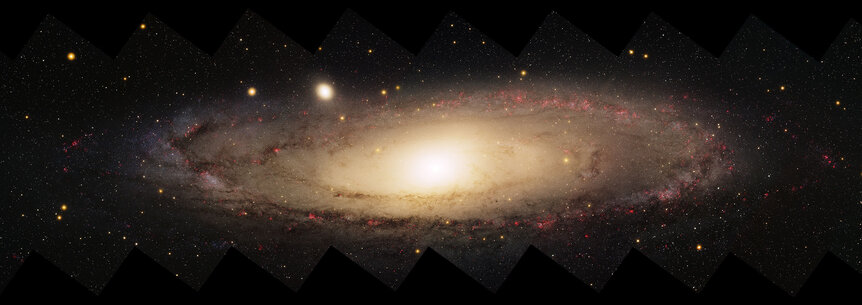Create a free profile to get unlimited access to exclusive videos, sweepstakes, and more!
Ultra-faint mini-galaxy found around the Milky Way’s sibling Andromeda
Super-dim galaxy Pegasus V may be the key to understanding the cosmos.

Astronomers have found an extremely faint and tiny galaxy in our cosmic neighbor’s back yard, and despite its diminutive nature it has big implications for our understanding of the Universe.
The galaxy is called Pegasus V, and all signs indicate it’s a satellite companion to the Andromeda Galaxy, a massive spiral much like our own Milky Way. Andromeda is about 2.5 million light years away, and together with the Milky Way dominate our small clutch of galaxies that we call the Local Group. Both Andromeda and we are surrounded by dozens of much smaller companion galaxies; even through a smallish telescope it’s possible to see M32 and NGC 205, a pair of dwarf elliptical galaxies near its center.
Pegasus V is much, much fainter, however. It was discovered by amateur astronomer Giuseppe Donatiello while examining the DESI Legacy Imaging Survey, a huge survey of the northern hemisphere sky that covers 14,000 square degrees: about 1/3rd of the entire sky*! It appeared as a very dim overdensity of light, so a team of astronomers took to the massive Gemini 8.1-meter telescope to get deeper images.
What they found is astonishing [link to paper]. Pegasus V really is dinky, probably only a few hundred light-years wide — the Milky Way is 120,000 light-years across, for comparison. It’s super faint, too, glowing with the light of only about 26,000 times that of the Sun. Mind you, a single massive star can shine more brightly than that!
The Gemini data allowed the astronomers to examine individual stars in the galaxy, which gave them two important characteristics: Its age and distance.
The stars in it are extremely old, so old that they have a severe lack of heavy elements in them. When the Universe was young it was almost entirely hydrogen and helium, and heavier elements like oxygen and iron were made inside stars that exploded at the ends of their lives and scattered those elements, which were then incorporated into later generations of stars. By measuring the amounts of these elements we can gauge the stars’ ages, and the paucity of them shows the stars of Pegasus V are old.
A different technique got an age of about 12.5 billion years, so the stars we see in it formed not all that long after the Big Bang itself! That’s actually important. When the Universe was extremely young the gas in it was so dense it was opaque to light, but then the first stars were born and their huge flood of ultraviolet light stripped electrons off the hydrogen atoms, making the Universe transparent. We call this the epoch of reionization, and it played a huge role in the evolution of the Universe.
That blast of UV light would’ve stripped the gas right out of small galaxies at the time, and we think that would’ve quenched any star formation. So, seeing stars 12.5 billion years old in Pegasus V means it might be a relic of that era, a fossil from reionization. That makes it a very tempting target for astronomers who want to understand that difficult-to-observe time in cosmic history.
Also, the distance of Pegasus V winds up being interesting as well. It lies about 2.3 million light-years from Earth, and about 850,000 light-years from the center of the Andromeda Galaxy. Lots of faint satellite galaxies for Andromeda have been found, some even as faint as Pegasus V, but they’re all much closer to the center of the bigger galaxy, discovered in targeted surveys. This is the first time one this faint has been seen in a survey that wasn’t specifically looking for them.
But more importantly the existence of Pegasus V implies there are likely a lot more that far from Andromeda, just waiting to be found. If so, that may help solve a big issue: the Dwarf Galaxy Problem. Models of how galaxies form predict there should be hundreds of small, faint galaxies orbiting Andromeda, but only a few dozen have been found. The thing is the faintest ones are really hard to spot, especially far out from Andromeda, so finding Pegasus V strongly indicates there are lots more to find, easing the tension of the predictions and the observations. If true, it means the models of how the early Universe forms galaxies may be a lot better than current observations indicate.
It’s kinda funny that a slightly shapeless faint blob in an image can have such a profound effect on our understanding, but sometimes the key to a lot of issues is just being able to find that first example. If Pegasus V is in fact the exemplar of a huge but dim population of nearby galaxies, it’ll have a lot of astronomers heaving sighs of relief.
* This isn’t Donatiello’s first faint galaxy discovery; he found another one a few years ago, too.




























